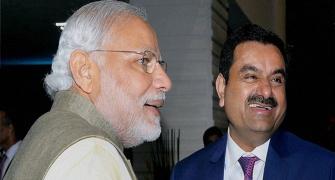Delhi Development Authority's land deal to Reliance Industries throws up larger issues of governance, says Laveesh Bhandari.
 Based on a PIL filed by The Citizens Alliance, a Delhi-based civil action group, the Delhi High Court recently acknowledged that there was a problem with the use of a large piece of land auctioned by the Delhi Development Authority (DDA), and bought by Reliance Industries Limited, for the purposes of a massive commercial centre (the word “mall” does not exist in Indian legalese yet).
Based on a PIL filed by The Citizens Alliance, a Delhi-based civil action group, the Delhi High Court recently acknowledged that there was a problem with the use of a large piece of land auctioned by the Delhi Development Authority (DDA), and bought by Reliance Industries Limited, for the purposes of a massive commercial centre (the word “mall” does not exist in Indian legalese yet).
It further directed the DDA to set up a committee of “stakeholders” which may include the traffic department but not the petitioner.
The judgement throws up the larger issues that plague governance in India.
It has serious ramifications for not just government land sale, but also public-private partnerships, regulation of land use and infrastructure creation.
The problem was seeded when the DDA obtained the urban land use permissions based on flawed information, one of them being a traffic study, the other being incorrect consideration of land size in deciding land use.
The traffic study was done by a consultant based on information provided by the DDA on that area. The DDA showed a wide road where none exists!
The traffic study showed that given the road there was adequate space for current and additional traffic to be cleared.
But that was not all; the land area was lower than as per the master plan’s requirements but the DDA gave an assurance to the Delhi Urban Arts Commission that it was adequate.
Based on this, the land use for a large commercial centre was obtained by the DDA.
The land was subsequently auctioned, and RIL and its sister companies’ bid won. Multiple entities took decisions on the basis of incorrect information provided by the DDA.
The larger contractual point before the Delhi High Court is this.
Can land-use decisions taken on the basis of incorrect information be considered to be valid?
But the court asked the DDA, the supplier of incorrect information, to form a committee that would reconsider the matter.
There is the obvious conflict of interest in this order.
Moreover, whichever way the DDA committee recommends, some party will have a good enough cause to protest.
The Citizens Alliance can protest that the recommender of the chief wrongdoer, the DDA, is biased; while the RIL can protest that it was given incorrect information, as even RIL would presumably have gotten the maps with the invisible road and flawed traffic study, not to mention the land use based on incorrect land size.
The allocation of regulatory or policy functions to the asset owner is a very common Indian institutional problem, and at some point India will need to separate these functions across the board.
If we do not, unnecessary time and resources will be spent by various stakeholders in such arguments, and result in wastage and delayed investment decisions.
There is another larger issue here. Systems within the government are extremely poor in allocating responsibility to people within.
When such oversight is missing, all kinds of flaws creep in and perverse actions get taken – such as planning one of Delhi’s largest malls in the middle of a residential area with four schools as immediate neighbours and not to mention five neighbourhood markets and community centres in the vicinity.
The officials have another very powerful tool that protects their poor decisions — the use of informational clutter, multiple and fuzzy definitions, informational gaps, and finally lack of responses.
Only a group of experts who understood how urban planning works, how maps get drawn, and traffic studies get done, how the numbers add up, how information needs to be extracted, collated and analysed, could have been convinced that there was a problem somewhere in the system.
And only deep coordination between such skill sets could have identified that missing road and incorrect land use classification hidden behind multiple layers of paper and official looking garbage.
In other words, the system in India screens out most demographic segments from non-political civil action.
There are lower middle class and poor in the area, they are as concerned as the mall will slow down the buses, further make difficult their ability to walk on the streets, and put a strain on supply of water and perhaps even power, but they don’t have the skill sets to decipher the paperwork, or resources to fight court cases. Street action is the only resort left for them.
Finally, if Mukesh Ambani, the chairman and managing director of RIL, were to ever visit the site, he would first throw out the managers who bought this land, and then the advisers who are making RIL fight for it.
They probably never bothered to see the location. You don’t have to be a traffic expert to see how the bumper to bumper peak hour traffic will reduce footfalls in what would be RILs showcase mall.
But RIL is too large, land worth a few hundred crore or a mall worth a few thousand probably gets hidden in the cracks.
The writer is an economist and also a member of The Citizens Alliance.
Photograph: Reuters









